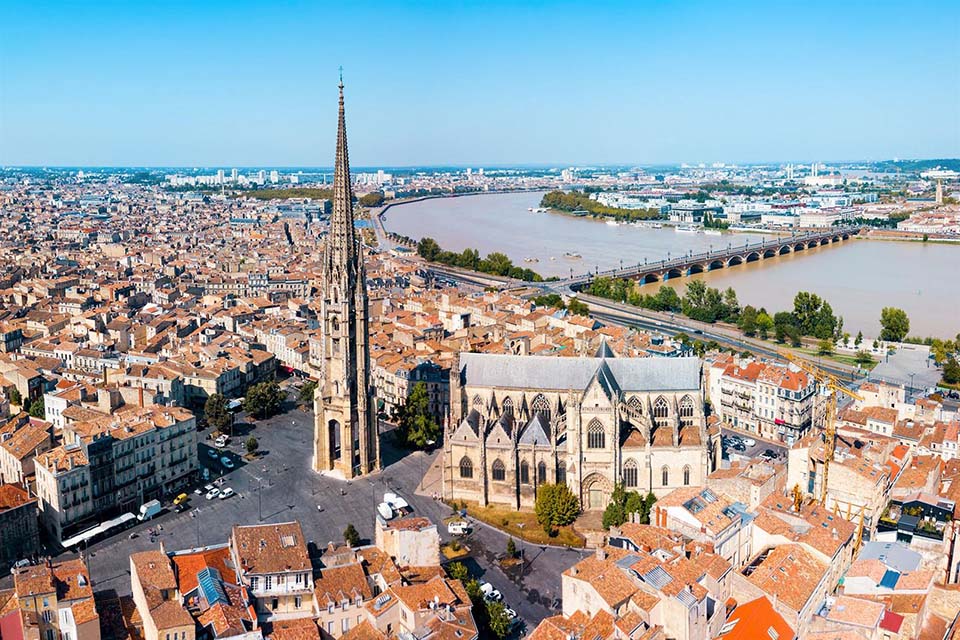
Some wine names simply ooze magic. Burgundian appellations such as Gevrey Chambertin, Nuits St George or Romanée-Conti can cause wine enthusiasts to become dreamy-eyed. The Bordeaux region also has its magic names too: Château Latour, Château Haut-Brion and Château Mouton Rothschild to name but three. And incidentally, these châteaux are some of the top wines of Bordeaux, they are the best wines of their type and command the highest prices. In comparison, names like Bushman’s Gully, Bruce Jack Daily Brew and Cloof Very Sexy Shiraz don’t quite carry the same sense of awe.
The Bordeaux region covers the whole area of the Gironde department near France’s Atlantic coast, with a total vineyard area of over four hundred square miles – the largest wine growing area in the country. The vine was introduced of course by the Romans, probably sometime during the first century as the Empire spread its power and influence over Western Europe.
You don’t hear the word “claret” very often these days, except in the traditional wine shops that still survive in Britain. It’s used to describe virtually any red wine from the Bordeaux region of France. The French never use the word. Oddly enough, it is always pronounced the English way to rhyme with “garret” and never pronounced in the French manner. If you pronounce it “claray” people will assume you are an ignorant twat.
In the fifteenth century, Bordeaux wine was lighter in colour than it is today and it was known as clairet, meaning “pale”. In Britain, it became Anglicized to “claret” and the word stuck. One of Britain’s oldest established wine merchants Berry Bros and Rudd sell a wine called Good Ordinary Claret which is a lot better than it sounds. It’s one of the company’s best-selling products.
Red Bordeaux is invariably made from a blend of grapes, notably Cabernet Sauvignon, Cabernet Franc and Merlot but sometimes the lesser-known Petit Verdot and Malbec are also added. There are more than eight thousand wine producers in Bordeaux and many use the name “Château” on the label. This doesn’t imply that the wines are made in castles. Far from it. Some châteaux are little more than a motley collection of undistinguished farm-like buildings. Other châteaux don’t exist at all because they are merely trade-names used by wine cooperatives to add a bit of class.
The majestically-named Fédération des Syndicats des Grands Vins de Bordeaux allows wine companies to sell identical wines under different and totally fictitious châteaux names. However, there is sometimes a degree of deception, if not downright dishonesty. Fictional names sometimes bear a striking resemblance to a genuine chateau, usually a highly respected one. They are clearly intended to mislead the careless shopper.
Château Haut Lamothe 2020 (red), Bordeaux, France (Bt. 659 @ Big C)
I first tasted this typical everyday claret about ten years ago. It was the 2011 vintage which then cost only Bt 559. But it’s always interesting to renew acquaintances, especially in the wine world. Looking back at my tasting notes of August 2013, this wine hasn’t changed much. Not surprising really, because everyday drinkers tend to be blended for consistency to make allowances for the variable weather conditions in cooler climates.
The first thing you’ll probably notice about this wine is the bottle. It’s a tall and rather elegant, with a coat-of-arms embossed near the neck presumably added to give it a bit of class. It would look good on any dining table. The wine is quite elegant too. It’s a deep, ruby red with purple hues and a pleasingly dry aroma of red berry, cherries and other peppery dark fruits. You might even pick up hints of spice. You’ll find that this oaky, ultra-dry wine is smooth on the palate and the cherry fruit rich but restrained in the Bordeaux tradition. There’s a satisfying layer of firm, dry grainy tannins, a slight mineral touch and a rewarding oaky finish.
At 13.5% ABV this seems to me a food wine. Its assertive character needs appropriately seasoned food and I think it would go well with many full-flavoured beef dishes of game. The label is strangely uninformative, but it shows a drawing of an elegant chateau which one assumes is the château itself. However, closer inspection reveals that the minuscule caption merely says (in French) “A Bordeaux-style house”. So it’s not the château at all. And to be quite honest, my guess is that this château exists in name only.
You’ve got to be careful about serving temperature with claret because the taste changes with the temperature. In cool climates, claret is served at the ambient temperature and never chilled. Too cold, and it tastes unyielding, tough and tannic. A higher temperature brings out the background aromas more readily, and softens the tannins and the texture of the wine. It makes for a more satisfying experience. This wine tasted best at the ambient temperature of my lounge, which must have been in the mid-twenties Celsius; normally considered too warm for red wine. I’d recommend that you first taste the wine at around the usual 18° C then allow the temperature to rise naturally. Taste it again and decide which you prefer. I can almost lay a bet that you’ll prefer the taste when the wine warms up a bit.






